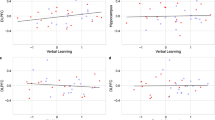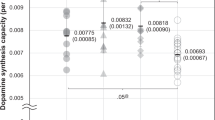Abstract
Schizophrenia is believed to involve altered activation of dopamine receptors, and support for this hypothesis conies from the antipsychotic effect of antagonists of the dopamine D2 receptor (D2R)1. D2R is expressed most highly in the striatum, but most of the recent positron emission tomography (PET) studies have failed to show any change in D2R densities in the striatum of schizophrenics2–5, raising the possibility that other receptors may also be involved. In particular, the dopamine D1 receptor (D1R), which is highly expressed in the prefrontal cortex6, has been implicated in the control of working memory7,8, and working memory dysfunction is a prominent feature of schizophrenia9. We have therefore used PET to examine the distribution of D1R and D2R in brains of drug-naive or drug-free schizophrenic patients. Although no differences were observed in the striatum relative to control subjects, binding of radioligand to D1R was reduced in the prefrontal cortex of schizophrenics. This reduction was related to the severity of the negative symptoms (for instance, emotional withdrawal) and to poor performance in the Wisconsin Card Sorting Test10. We propose that dysfunction of D1R signalling in the prefrontal cortex may contribute to the negative symptoms and cognitive deficits seen in schizophrenia.
This is a preview of subscription content, access via your institution
Access options
Subscribe to this journal
Receive 51 print issues and online access
$199.00 per year
only $3.90 per issue
Buy this article
- Purchase on Springer Link
- Instant access to full article PDF
Prices may be subject to local taxes which are calculated during checkout
Similar content being viewed by others
References
Seeman, P., Lee, T., Chau-Wong, M. & Wong, K. Nature 261, 717–719 (1976).
Hietala, J. et al. Archs Gen. Psychiat. 51, 116–123 (1994).
Martinot, J. L., Person-Magnan, P., Huret, J. D. & Mazoyer, B. Am. J. Psychiat. 147, 44–50 (1990).
Nordström, A. L., Farde, L., Eriksson, L. & Halldin, C. Psychiat. Res. Neuroimag. 61, 67–83 (1995).
Farde, L. et al. Archs Gen. Psychiat. 47, 213–219 (1990).
Hall, H. et al. Neuropsychopharmacology 11, 245–256 (1994).
Sawaguchi, T. & Goldman-Rakic, P. S. Science 251, 947–950 (1991).
Williams, G. V. & Goldman-Rakic, P. S. Nature 376, 572–575 (1995).
Goldman-Rakic, P. S. J. Neuropsychiat. Clin. Neurosci. 6, 348–357 (1994).
Kashima. H. Jpn J. Psychopharmacol. 11, 83–88 (1991).
Farde, L., Halldin, C., Stone, E. S. & Sedvall, G. Psychopharmacology 92, 278–284 (1987).
Anderson, P. & Gronvald, F. Life Sci. 38, 1507–1514 (1986).
Wong, D. F. et al. Science 226, 1393–1396 (1984).
Hess, E. J., Bracha, H. S., Kleinman, J. E. & Creese, I. Life Sci. 40, 1487–1497 (1987).
Sedvall, G. & Farde, L. Lancet 346, 743–749 (1995).
Mintun, M. A., Raichle, M. E., Kilbourn, M. R., Wooten, G. F. & Welch, M. J. Ann. Neural. 15, 217–227 (1984).
Weinberger, D. R., Berman, K. F. & Zec, R. F. Archs Gen. Psychiat. 43, 114–124 (1986).
Brozoski, T., Brown, R., Rosvold, H. & Goldman-Rakic, P. S. Science 205, 929–931 (1979).
Davidson, M. & Davis, K. Archs Gen Psychiat. 45, 561–563 (1988).
Daniel, D., Weinberger, D. & Jones, D. J. Neurosci. 11, 1907–1917 (1991).
Dolan, R. J. et al. Nature 378, 180–182 (1995).
Asahina, M. et al. Acta Neurol. Scand. 91, 437–443 (1995).
Suhara, T. et al. Psychopharmacology 103, 41–45 (1991).
Patlak, C. & Blasberg, R. J. Cereb. Blood Flow Metab. 5, 584–590 (1985).
Author information
Authors and Affiliations
Rights and permissions
About this article
Cite this article
Okubo, Y., Suhara, T., Suzuki, K. et al. Decreased prefrontal dopamine D1 receptors in schizophrenia revealed by PET. Nature 385, 634–636 (1997). https://doi.org/10.1038/385634a0
Received:
Accepted:
Issue Date:
DOI: https://doi.org/10.1038/385634a0
This article is cited by
-
Mechanisms of synaptic transmission dysregulation in the prefrontal cortex: pathophysiological implications
Molecular Psychiatry (2022)
-
The interplay of dopamine metabolism abnormalities and mitochondrial defects in the pathogenesis of schizophrenia
Translational Psychiatry (2022)
-
Dopamine-induced pruning in monocyte-derived-neuronal-like cells (MDNCs) from patients with schizophrenia
Molecular Psychiatry (2022)
-
Resting-state dopaminergic cell firing in the ventral tegmental area negatively regulates affiliative social interactions in a developmental animal model of schizophrenia
Translational Psychiatry (2021)
-
An experimental medicine study of the phosphodiesterase-4 inhibitor, roflumilast, on working memory-related brain activity and episodic memory in schizophrenia patients
Psychopharmacology (2021)
Comments
By submitting a comment you agree to abide by our Terms and Community Guidelines. If you find something abusive or that does not comply with our terms or guidelines please flag it as inappropriate.



